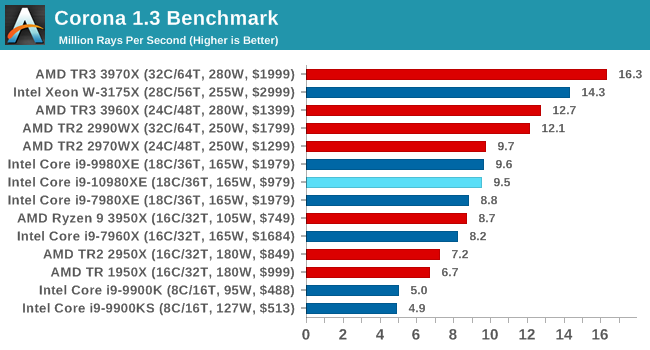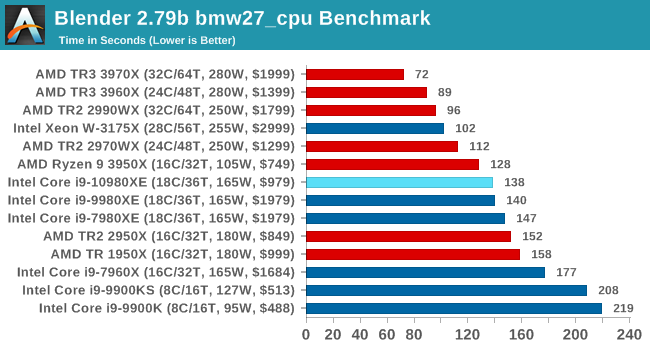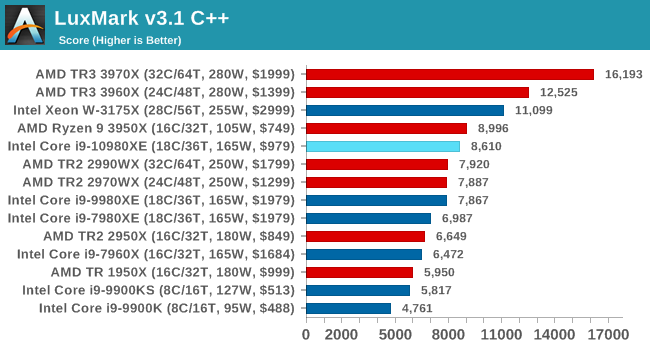It’s a Cascade of 14nm CPUs: AnandTech’s Intel Core i9-10980XE Review
by Dr. Ian Cutress on November 25, 2019 9:00 AM ESTCPU Performance: Rendering Tests
Rendering is often a key target for processor workloads, lending itself to a professional environment. It comes in different formats as well, from 3D rendering through rasterization, such as games, or by ray tracing, and invokes the ability of the software to manage meshes, textures, collisions, aliasing, physics (in animations), and discarding unnecessary work. Most renderers offer CPU code paths, while a few use GPUs and select environments use FPGAs or dedicated ASICs. For big studios however, CPUs are still the hardware of choice.
All of our benchmark results can also be found in our benchmark engine, Bench.
Corona 1.3: Performance Render
An advanced performance based renderer for software such as 3ds Max and Cinema 4D, the Corona benchmark renders a generated scene as a standard under its 1.3 software version. Normally the GUI implementation of the benchmark shows the scene being built, and allows the user to upload the result as a ‘time to complete’.
We got in contact with the developer who gave us a command line version of the benchmark that does a direct output of results. Rather than reporting time, we report the average number of rays per second across six runs, as the performance scaling of a result per unit time is typically visually easier to understand.
The Corona benchmark website can be found at https://corona-renderer.com/benchmark

The 10980XE sits on par with the 9980XE, but no real difference in performance.
Blender 2.79b: 3D Creation Suite
A high profile rendering tool, Blender is open-source allowing for massive amounts of configurability, and is used by a number of high-profile animation studios worldwide. The organization recently released a Blender benchmark package, a couple of weeks after we had narrowed our Blender test for our new suite, however their test can take over an hour. For our results, we run one of the sub-tests in that suite through the command line - a standard ‘bmw27’ scene in CPU only mode, and measure the time to complete the render.
Blender can be downloaded at https://www.blender.org/download/

Again, pretty much on par with the 9980XE.
LuxMark v3.1: LuxRender via Different Code Paths
As stated at the top, there are many different ways to process rendering data: CPU, GPU, Accelerator, and others. On top of that, there are many frameworks and APIs in which to program, depending on how the software will be used. LuxMark, a benchmark developed using the LuxRender engine, offers several different scenes and APIs.
In our test, we run the simple ‘Ball’ scene. This scene starts with a rough render and slowly improves the quality over two minutes, giving a final result in what is essentially an average ‘kilorays per second’.

We see a small uplift here compared to the 9980XE, but the 10980XE still sits behind the 3950X.
POV-Ray 3.7.1: Ray Tracing
The Persistence of Vision ray tracing engine is another well-known benchmarking tool, which was in a state of relative hibernation until AMD released its Zen processors, to which suddenly both Intel and AMD were submitting code to the main branch of the open source project. For our test, we use the built-in benchmark for all-cores, called from the command line.
POV-Ray can be downloaded from http://www.povray.org/

Another parity between the 10980XE and the 9980XE.











79 Comments
View All Comments
wow&wow - Monday, November 25, 2019 - link
‘consumers don’t care about process nodes, so you shouldn’t either’The ex-CEO said, Intel processors function as intended, no bug, so using the design shortcut of partial addresses, causing many more security holes than AMD's, is intended, and enterprise and consumers don't care, so you shouldn’t either!
The more the security holes, the more the demand; what an amazing company and business!
nt300 - Tuesday, November 26, 2019 - link
Intel Processors even dating back to 2008+ all have massive amounts of security and malware vulnerabilities nightmare. Not only is ZEN superior technologically, its faster, securer and much more cost effective.HideOut - Monday, November 25, 2019 - link
You state that the AMD loses on PCI lanes but those PCI lanes are 4.0 vs 3.0. They are twice as fast per lane. With the right hardware the total bandwidth is the exact same.Thanny - Wednesday, November 27, 2019 - link
Which means nothing if you can't use your RAID controller or 10g network card because there aren't enough lanes to create the required expansion slots.I don't think there's a single X570 board capable of running a computer with a RAID controller or 10g network card, both of which require x8 slots. You could, in principle, bifurcate lanes to create more slots, but no one does that. So the fact that the lanes are PCIe 4.0 is utterly irrelevant.
If you want a non-toy computer, you need either Intel's -E/-X series processors, or, since 2017, AMD's Threadripper processors.
kc77 - Tuesday, November 26, 2019 - link
That summary makes no sense. The desktop AMD chip is beating the HEDT one with a $500 savings when you factor in motherboard cost. It's even beating it in gaming.If you picked up an older threadripper part for productivity it will walk all over the HEDT part and still be cheaper.
It doesn't matter what Intel does there's an AMD part available for cheaper.
Thanny - Wednesday, November 27, 2019 - link
TR 2000 is now cheaper, but its per-core performance lags behind Cascade Lake-X. It also has a higher-latency topology. If you want a real computer capable of running a RAID controller and 10g network card, for example, that also games reasonably well, and don't need really high core counts, then you'll get better results with Cascade Lake-X at the lower end.AMD has blundered. They should have released a 16-core Zen 2 chip, made it compatible with X399, and made it no more expensive than the MSRP of the 2950X.
kc77 - Wednesday, November 27, 2019 - link
If you're going HEDT you need the cores that's the whole point. Further more if you need ECC you won't get that with these HEDT parts while you will on all Ryzen CPUs from the bottom to the top.For HEDT ECC can be mandatory. If you want that with Intel you'll spend an extra $1000. Nope not joking.
Jimbo Jones - Friday, November 29, 2019 - link
"If you need HEDT but don't need cores ..."i7-7740x anyone? That CPU was laughed out of existence. Even the 8 core AMD TR died a quick death. That's how many people need a low core count HEDT processor.
peevee - Wednesday, November 27, 2019 - link
AMD NEEDS 20-core TR right under $1000 to fill the gap between $750 3950X and $1400 3650X and take the ground from under Intel's 18-core part. Unfortunately, they are almost out of numbers. 3955X? ;)They would benefit from a $800 16-core part too, perfect for those who are limited by PCI lanes or memory on 3950X.
Thanny - Wednesday, November 27, 2019 - link
As I see it, AMD is being daft by not releasing an X399-compatible 16-core Threadripper 3955X based on Zen 2.